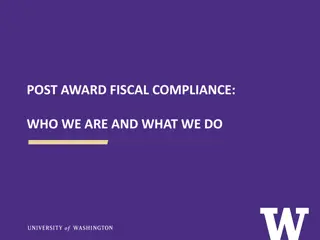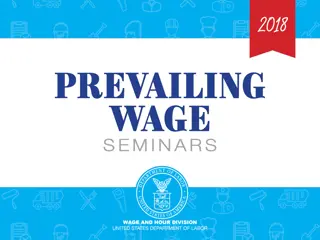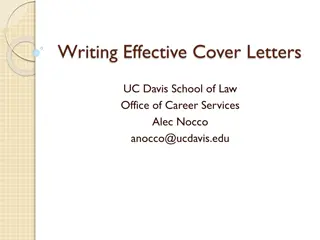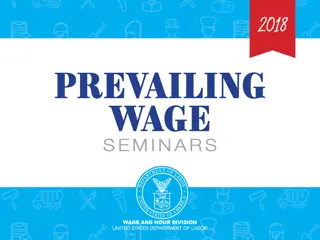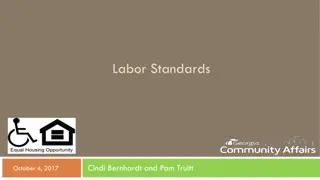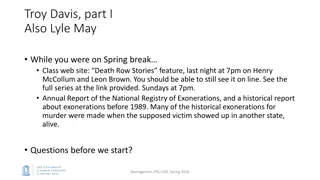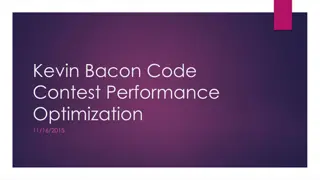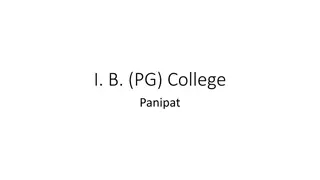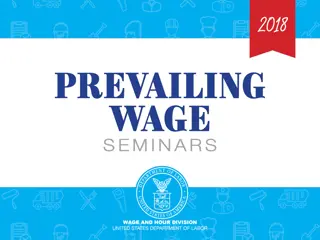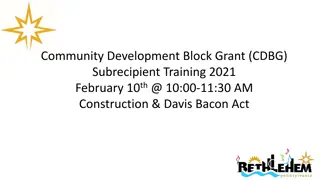Overview of Davis-Bacon Compliance
Davis-Bacon compliance covers contracts exceeding $2,000 with the Federal Government or DC for construction, alteration, repair, and more. It includes labor standards, wage determinations, and selecting the correct determination.
Download Presentation

Please find below an Image/Link to download the presentation.
The content on the website is provided AS IS for your information and personal use only. It may not be sold, licensed, or shared on other websites without obtaining consent from the author.If you encounter any issues during the download, it is possible that the publisher has removed the file from their server.
You are allowed to download the files provided on this website for personal or commercial use, subject to the condition that they are used lawfully. All files are the property of their respective owners.
The content on the website is provided AS IS for your information and personal use only. It may not be sold, licensed, or shared on other websites without obtaining consent from the author.
E N D
Presentation Transcript
Davis Bacon 101 An Overview of Davis Bacon Compliance
DBA Coverage Applies to contracts in excess of $2,000 to which the Federal Government or the District of Columbia is a party for construction, alteration, and/or repair, including painting and decorating, of public buildings or public works.
Davis Bacon Related Acts Davis-Bacon (DB) requirements extend to numerous related Acts that provide federal assistance by Grants Loans Loan guarantees Insurance
Davis Bacon Labor Standards/Contract Stipulations The term labor standards means the requirements of: The Davis-Bacon Act; The Contract Work Hours and Safety Standards Act; The Copeland Act; Prevailing wage provisions of the Davis-Bacon and related Acts ; and Regulations, 29 CFR 1, 3, and 5.
Wage Determinations Davis-Bacon WDs specify the prevailing wages, including fringe benefits, which are determined to be prevailing for the described classes of laborers and mechanics employed on construction projects of a similar character in the localities specified therein. Two types of wage determinations: general and project
Selecting the Correct Wage Determination Selecting and incorporating the appropriate general wage determination for the project type Building Residential Heavy Highway Guidance provided in AAM 130 Multiple wage determinations may apply where there are separate construction types and the different type of construction is at least 20 percent of the project cost or exceeds $1 million guidance provided in AAM 131
Selecting the Correct Wage Determination Incorporate most current WD: Negotiated contracts ( RFPs ) Time of award. Competitively bids contracts: In effect 10 days or more before opening of bids. Exceptions. If the contract is not warded within 90 days of bid opening, any modification to the WD must be incorporated unless the federal agency requests and obtains an extension of the 90 day period.
Interpreting General Wage Determinations Useful information contained in a general wage determination: State and county Type of construction with description Record of modifications List of classifications and rates Basis for rates Identifiers Union Identifiers Union Weighted Average Identifiers SU Identifiers
Conformances Unlisted classifications needed for work not included within the scope of the classifications listed may be added after award only as provided in the labor standards contract clauses (29CFR 5.5 (a) (1) (ii)). Conformance requirements: The work to be performed by the proposed classification is not performed by a classification already in the wage determination (WD); The proposed wage rate must bear a reasonable relationship to WD rates; and The proposed classification is utilized in the area by the construction industry.
Wage Determinations Contracting Agency Responsibilities Ensure proper wage determination (WD) is identified and applied; Advise contractors which schedule of rates applies to various construction items; and Advise contractors regarding the duties performed by various crafts in the WD.
Wages & Fringe Benefits All laborers and mechanics employed or working upon the site of work must be paid at least the applicable prevailing wage rate for the classification of work performed as listed in the applicable wage determination or a rate approved in accordance with the conformance process set forth at 29 C.F.R. 5.5(a)(1)(ii), without regard to skill. The laborers and mechanics working on the site of work must be paid weekly unless the fringe benefits are paid into a bona fide FB plan and then contributions must be paid no less often then quarterly.
Wages and Fringe Benefits Laborers and mechanics shall be paid the appropriate wage rate and fringe benefits on the wage determination for the classification of work actually performed, without regard to skill Laborers and mechanics who perform work in more than one classification may be paid the different applicable rates for the work they actually perform if the employer keeps an accurate record of the time spent working in each classification and pays accordingly
Wages and Fringe Benefits Under DBA, FB s are a component of the DBA prevailing wage. The prevailing wage obligation may be satisfied by: Paying the base hourly rate (BHR) and FB in cash (including negotiable instruments payable on demand); Contributing payments to a bona fide plan; or Any combination of the two. Cash wages paid in excess of BHR may count to offset or satisfy the FB obligation (unlike under SCA)
Funded Fringe Benefit Plans Contractors may take credit (without prior approval from DOL) for bona fide FB fund contributions made to third-party trustees or insurers that: Are irrevocably paid; and Are made regularly, not less often than quarterly. Credit is for payments made for individual workers eligible to participate in the plan, program, or fund.
Unfunded Fringe Benefit Plans Costs for an unfunded FB plan count towards WD obligation if specific criteria are met: The contributions reasonably anticipate the cost to provide a bona fide FB; Contributions are made pursuant to an enforceable commitment; That is carried out under a financially responsible plan; and The plan has been communicated in writing to affected workers.
Certified Payrolls Two separate contract clause requirements apply to certified payrolls for a project: The contractor shall submit weekly for any week in which any contract work is performed a copy of all payrolls. 29 C.F.R. 5.5(a)(3)(ii)(A). Each weekly payroll submitted must be accompanied by a Statement of Compliance. 29 C.F.R. 5.5(a)(3)(ii)(B).
Certified Payrolls Weekly payrolls must include specific information as required by 29 C.F.R. 5.5(a)(3). Weekly payroll information may be submitted in any form desired. Optional Form WH-347 is available for this purpose The WH-347 form, with instructions, is at: http://www.dol.gov/whd/forms/wh347instr.htm.
Investigations DOL Functions/Responsibilities: Determining prevailing wages ; Issuing regulations and standards to be observed by contracting agencies; and Perform oversight function and has independent authority to conduct investigations. In addition to including the contract stipulations and correct wage determinations, contracting agencies also have the authority to conduct investigations
Investigative Process Initial conference with employer. Examine certified payrolls. Examine basic payroll records. Check for compliance with apprenticeship and/or trainee requirements. Interview employees Determine if a conformance is necessary. Compute back wages and liquidated damages, if any Final conference with employer to discuss results of the investigation
Withholding DBA and CWHSSA provide for withholding of contract funds to satisfy alleged wage underpayments pending resolution of a wage dispute. 40 U.S.C. 3142(c)(3); 40 U.S.C. 3702(d). Withholding of contract funds is an effective enforcement tool in DBA/DBRA/CWHSSA cases. It protects the rights of covered workers to wages due them.
Withholding of Contract Funds FAR (48 C.F.R. Part 22) FAR guidance in 48 C.F.R. Part 22 instructs that if the contracting officer believes a violation exists, or upon request of the Department of Labor: the contracting officer must withhold from payments due the contractor an amount equal to the estimated wage underpayment and estimated liquidated damages due under the CWHSSA. 48 C.F.R. 22.406-9(a).
Withholding of Contract Funds FAR (48 C.F.R. Part 22, cont d.) If subsequent investigation confirms violations, the contracting officer must adjust the withholding as necessary. If DOL requested the withholding, the contracting officer must not reduce or release the withheld funds without written approval by DOL. The withheld funds are to be used to satisfy: assessed liquidated damages; and unless the contractor makes restitution, validated wage underpayments.
Debarment Occurs when a contractor is declared ineligible for future contracts due to: Violations of the DBA in disregard of its obligations to employees or subcontractors. Aggravated or willful violations under the labor standards provisions of related Acts. Period of ineligibility is 3 years for DBA and up to 3 years for DBRA. The debarment process is given at 29 CFR 5.12(b)
Debarment Criteria Debarment is considered when a contractor has: Submitted falsified certified payrolls; Required kickbacks of wages or back wages; Committed repeat violations; Committed serious violations; Misclassified covered workers in clear disregard of proper classification norms; and/or As a prime contractor, failed to ensure compliance by subcontractors.
AAM Guidance Referral to WHD Refusal-to- Pay & Debarment Cases AAM No. 215, dated March 7, 2014 provides contracting agencies with guidance regarding: Referral of refusal-to-pay and debarment cases to the WHD regional offices; and Procedures for contracting agencies to use in sending withheld funds due covered laborers and mechanics to WHD for disbursement.
Internet Sites Wage Determinations http://www.wdol.gov Wage and Hour Division - http://www.dol.gov/whd/index.htm Resource Book - http://www.dol.gov/whd/recovery/pwrb/toc.htm Office of the Administrative Law Judges Law Library - http://www.oalj.dol.gov Administrative Review Board - http://www.dol.gov/arb
Disclaimer This presentation is intended as general information only and does not carry the force of legal opinion. The Department of Labor is providing this information as a public service. This information and related materials are presented to give the public access to information on Department of Labor programs. You should be aware that, while we try to keep the information timely and accurate, there will often be a delay between official publications of the materials and the modification of these pages. Therefore, we make no express or implied guarantees. The Federal Register and the Code of Federal Regulations remain the official source for regulatory information published by the Department of Labor. We will make every effort to keep this information current and to correct errors brought to our attention.









